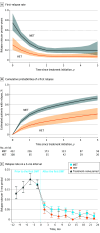Highly Effective Therapies as First-Line Treatment for Pediatric-Onset Multiple Sclerosis
- PMID: 38345791
- PMCID: PMC10862269
- DOI: 10.1001/jamaneurol.2023.5566
Highly Effective Therapies as First-Line Treatment for Pediatric-Onset Multiple Sclerosis
Abstract
Importance: Moderately effective therapies (METs) have been the main treatment in pediatric-onset multiple sclerosis (POMS) for years. Despite the expanding use of highly effective therapies (HETs), treatment strategies for POMS still lack consensus.
Objective: To assess the real-world association of HET as an index treatment compared with MET with disease activity.
Design, setting, and participants: This was a retrospective cohort study conducted from January 1, 2010, to December 8, 2022, until the last recorded visit. The median follow-up was 5.8 years. A total of 36 French MS centers participated in the Observatoire Français de la Sclérose en Plaques (OFSEP) cohort. Of the total participants in OFSEP, only treatment-naive children with relapsing-remitting POMS who received a first HET or MET before adulthood and at least 1 follow-up clinical visit were included in the study. All eligible participants were included in the study, and none declined to participate.
Exposure: HET or MET at treatment initiation.
Main outcomes and measures: The primary outcome was the time to first relapse after treatment. Secondary outcomes were annualized relapse rate (ARR), magnetic resonance imaging (MRI) activity, time to Expanded Disability Status Scale (EDSS) progression, tertiary education attainment, and treatment safety/tolerability. An adapted statistical method was used to model the logarithm of event rate by penalized splines of time, allowing adjustment for effects of covariates that is sensitive to nonlinearity and interactions.
Results: Of the 3841 children (5.2% of 74 367 total participants in OFSEP), 530 patients (mean [SD] age, 16.0 [1.8] years; 364 female [68.7%]) were included in the study. In study patients, both treatment strategies were associated with a reduced risk of first relapse within the first 2 years. HET dampened disease activity with a 54% reduction in first relapse risk (adjusted hazard ratio [HR], 0.46; 95% CI, 0.31-0.67; P < .001) sustained over 5 years, confirmed on MRI activity (adjusted odds ratio [OR], 0.34; 95% CI, 0.18-0.66; P = .001), and with a better tolerability pattern than MET. The risk of discontinuation at 2 years was 6 times higher with MET (HR, 5.97; 95% CI, 2.92-12.20). The primary reasons for treatment discontinuation were lack of efficacy and intolerance. Index treatment was not associated with EDSS progression or tertiary education attainment (adjusted OR, 0.51; 95% CI, 0.24-1.10; P = .09).
Conclusions and relevance: Results of this cohort study suggest that compared with MET, initial HET in POMS was associated with a reduction in the risk of first relapse with an optimal outcome within the first 2 years and was associated with a lower rate of treatment switching and a better midterm tolerance in children. These findings suggest prioritizing initial HET in POMS, although long-term safety studies are needed.
Conflict of interest statement
Figures



References
-
- Chitnis T, Banwell B, Kappos L, et al. ; TERIKIDS Investigators . Safety and efficacy of teriflunomide in paediatric multiple sclerosis (TERIKIDS): a multicentre, double-blind, phase 3, randomised, placebo-controlled trial. Lancet Neurol. 2021;20(12):1001-1011. doi:10.1016/S1474-4422(21)00364-1 - DOI - PubMed
Publication types
MeSH terms
LinkOut - more resources
Full Text Sources
Medical
Research Materials
Miscellaneous

